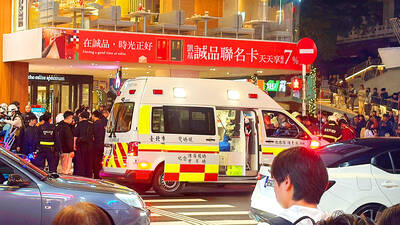Faced with potential personnel shortages and the need to free resources for critical care, the National Health Insurance Administration (NHIA) is hoping to significantly cut outpatient visits to bigger hospitals in the near future, NHIA Director-General Lee Po-chang (李伯璋) said yesterday.
The agency has set a goal of cutting outpatient visits to medical centers and regional hospitals by 10 percent over the next five years, Lee said.
Last year, there were 30.69 million outpatient visits to medical centers, up from 25.62 million in 2010, and 41.14 million outpatient visits to regional hospitals, up from 33.46 million in 2010.
If the goal is achieved, the rapid growth in outpatient visits to the two types of medical establishments seen over the past seven years could be reversed and would fall by a combined 7 million over the next five years, Lee said.
The nation has tried for more than a decade to institute a multi-tiered healthcare system designed to get the most out of its medical resources.
Under the system, the best-equipped medical facilities — medical centers and regional hospitals — are responsible for handling serious illnesses or critical cases while leaving less urgent or more routine cases to district hospitals and clinics.
The issue has taken on new urgency, because doctors will start to be covered by the Labor Standards Act (勞動基準法) in 2019, possibly cutting the amount of time they can work and creating a personnel shortage at major hospitals, Lee said.
With that in mind and to ensure that big hospitals have sufficient resources for critical and emergency care, the NHIA needs to channel outpatients to smaller healthcare facilities, Lee said.
The initiative would see doctors at medical centers and regional hospitals transfer patients diagnosed with minor ailments to district hospitals and clinics to avoid wasting medical resources, he said.
At the same time, patients with serious conditions who first visit district hospitals and clinics should be transferred to medical centers and regional hospitals, he said.
About 12 to 14 percent of outpatient cases at medical centers and 20 percent of those at regional hospitals involve basic medical care, such as respiratory infections, conjunctivitis, abrasions or fungal infections, Lee said.
In other words, about one in every five to eight outpatients may be using resources that would better serve people with more serious ailments, he said.

TRAGEDY STRIKES TAIPEI: The suspect died after falling off a building after he threw smoke grenades into Taipei Main Station and went on a killing spree in Zhongshan A 27-year-old suspect allegedly threw smoke grenades in Taipei Main Station and then proceeded to Zhongshan MRT Station in a random killing spree that resulted in the death of the suspect and two other civilians, and seven injured, including one in critical condition, as of press time last night. The suspect, identified as a man surnamed Chang Wen (張文), allegedly began the attack at Taipei Main Station, the Taipei Fire Department said, adding that it received a report at 5:24pm that smoke grenades had been thrown in the station. One man in his 50s was rushed to hospital after a cardiac arrest

A car bomb killed a senior Russian general in southern Moscow yesterday morning, the latest high-profile army figure to be blown up in a blast that came just hours after Russian and Ukrainian delegates held separate talks in Miami on a plan to end the war. Kyiv has not commented on the incident, but Russian investigators said they were probing whether the blast was “linked” to “Ukrainian special forces.” The attack was similar to other assassinations of generals and pro-war figures that have either been claimed, or are widely believed to have been orchestrated, by Ukraine. Russian Lieutenant General Fanil Sarvarov, 56, head

SAFETY FIRST: Double the number of police were deployed at the Taipei Marathon, while other cities released plans to bolster public event safety Authorities across Taiwan have stepped up security measures ahead of Christmas and New Year events, following a knife and smoke bomb attack in Taipei on Friday that left four people dead and 11 injured. In a bid to prevent potential copycat incidents, police deployments have been expanded for large gatherings, transport hubs, and other crowded public spaces, according to official statements from police and city authorities. Taipei Mayor Chiang Wan-an (蔣萬安) said the city has “comprehensively raised security readiness” in crowded areas, increased police deployments with armed officers, and intensified patrols during weekends and nighttime hours. For large-scale events, security checkpoints and explosives

PUBLIC SAFETY: The premier said that security would be tightened in transport hubs, while President Lai commended the public for their bravery The government is to deploy more police, including rapid response units, in crowded public areas to ensure a swift response to any threats, President William Lai (賴清德) said yesterday after a knife attack killed three people and injured 11 in Taipei the previous day. Lai made the remarks following a briefing by the National Police Agency on the progress of the investigation, saying that the attack underscored the importance of cooperation in public security between the central and local governments. The attack unfolded in the early evening on Friday around Taipei Main Station’s M7 exit and later near the Taipei MRT’s Zhongshan